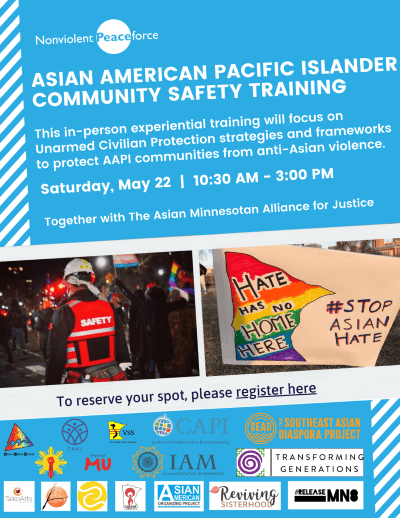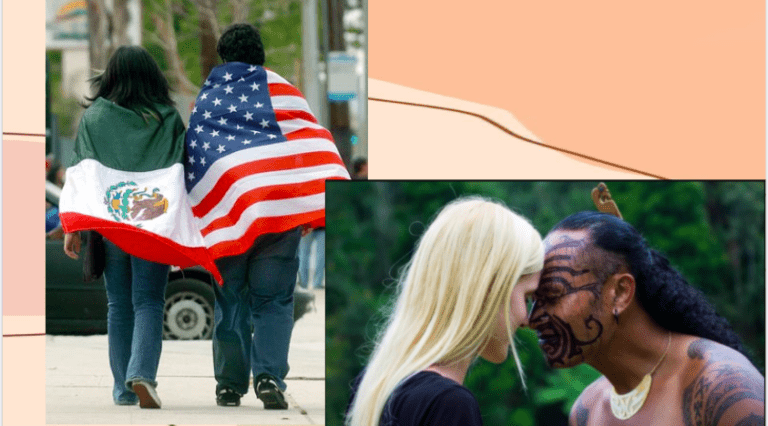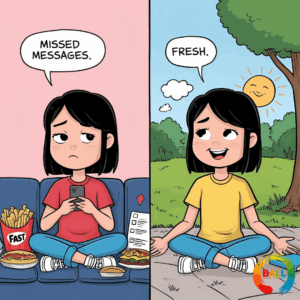This training was facilitated by Kalaya’an Mendoza (Kala from here on), Director of the US Programs for Nonviolent Peaceforce (NP). NP is a global civilian protection agency – to protect civilians in violent conflicts through unarmed strategies, build peace side by side with local communities. Kala has been activating Community Safety Teams in neighborhoods and at demonstrations at flashpoints, most recently during the Derek Chauvin trial and the protests in Brooklyn Park after the Daunte Wright killing.
On May 22nd, Kala’s training was grounded in “Unarmed Civilian Protection” framework with a focus on building skillsets around: Situational Awareness, Upstander Intervention, Unarmed Civilian Protection and Tactical Communications. These skillsets can be used during community/event gatherings, as well as for personal safeties or to help out someone in distress.
BEFORE the event, Kala reminded us to pay attention to our own trigger points, boundaries and anchor points:
⚓️ Make time to center yourself the night before and morning of a protective action and identify an anchor point—a place of emotional safety.
⏹ Before arriving, take a few moments to consider boundaries and potential triggers, and remember your anchor point.
👥 Make time to discuss your boundaries with your team when you meet up before the action.
🗯 Remember to check in with your team throughout the day and make time for appropriate aftercare.
This process is going to look different for everyone, but making it a habit is crucial to stay safe in high-stress situations and avoid burnout.
DURING the event, Kala emphasized the OODA Loop to act on people’s best observations and judgement!
🔎 Observe: draw from your own observations and information you have collected from trusted sources
⏱ Orient: Filter and analyze your information
❓ Decide: With your insights, identify the best available response
🎬 Act: act on your decision, evaluate if action was correct
Kala gave many examples of deescalation through distraction. People don’t need anything fancy, just enough of a distraction to create a moment of pause and ease the conflict, such as:
💁 Compliment or Money Talk– “You look great!” or “Look! $100 bill on the floor.”
🎙🕺 Dancing or Singing
🔎 Pretending you lost something, asking people to find it
⌚️ Asking for the time
Asking for directions
❓ Asking “Do I Know You?”
While some deescalate, others can be acting as witnesses to record the situations or finding teams of people to be together. The aim with deescalation is not to win over someone with whom you disagree, but it is to deescalate to a point where everyone can be safe instead of further escalating volatile situations.
Kala also shared the CLARA Method while responding to questions and verbal attacks, with these five steps:
- 1️ – Center
- 2️ – Listen 👂
- 3️ – Affirm 🔗
- 4️ – Respond 🗣
- 5️ – Add ➕
AFTER the event, Kala reaffirmed us the importance of self-care – “Caring for yourself to care for others,” especially many AAPIs may feel culturally guilty to take care of oneself first and not others. Again, Kala reminded us only a mentally, physically, and spiritually balanced self can support self and others.
After the whole day of general training, Kala invited few AAPI leaders for “Train-the-Trainers” session, and each team had a chance to practice the OODA Loop with diverse interactive activities – Observe; Orient; Decide; and Act – OODA Loop can become an instinct among all the trainers with practices.
During these civil unrests and high alerts of Anti-Asian Hate incidences, everyone of us has to learn how to protect each other, and to avoid escalation and violent actions. We all need to practice these deescalation techniques so they become natural reactions, and we are ready to support the “Unarmed Civilian Protection” vision.
If you have questions or need more information, please check out Nonviolent Peaceforce (NP)’s website – https://www.nonviolentpeaceforce.org/, or report hate crime incidences at MN with toll-free helpline 1-833-454-0148.








